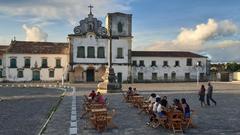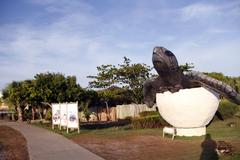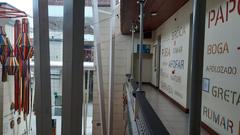
Visiting Guide for Praça São Francisco, Aracaju
Date: 19/07/2024
Introduction
Praça São Francisco, located in São Cristóvão within the metropolitan area of Aracaju, Brazil, is a historical gem that has captivated visitors for centuries. Established in the early 17th century, the square is a testament to the rich colonial history of Brazil and showcases a unique blend of Portuguese and Spanish architectural influences. Recognized as a UNESCO World Heritage Site in 2010 (UNESCO), Praça São Francisco offers visitors a chance to immerse themselves in the cultural and historical ambiance of the colonial era. This guide provides a comprehensive overview of Praça São Francisco, covering its history, cultural significance, visitor information, and practical tips to ensure a memorable visit. Whether you are a history enthusiast, architecture aficionado, or simply a curious traveler, this guide will help you navigate through the fascinating world of Praça São Francisco.
Table of Contents
- Introduction
- History of Praça São Francisco
- Cultural Significance
- Visitor Information
- Nearby Attractions
- Special Events and Guided Tours
- Best Photographic Spots
- FAQ
- Conclusion and Call to Action
- References
History of Praça São Francisco
Origins and Early Development
Praça São Francisco was established in 1607 by the Portuguese during the colonial period. São Cristóvão itself was founded in 1590 by Cristóvão de Barros, making it one of the oldest cities in Brazil. The square was designed following the typical Portuguese colonial urban planning, which included a central plaza surrounded by important civic and religious buildings.
Architectural Significance
The architectural ensemble of Praça São Francisco is a testament to the blending of European and local influences. The square is surrounded by significant structures, including the Church and Convent of São Francisco, the Church of Santa Casa de Misericórdia, and the Provincial Palace. These buildings exhibit a mix of Gothic, Baroque, and Mannerist styles, reflecting the architectural trends of the time.
The Church and Convent of São Francisco, constructed between 1693 and 1699, is particularly notable for its intricate woodwork and azulejos (Portuguese ceramic tiles). The convent served as a religious and educational center, playing a crucial role in the spread of Catholicism in the region.
Historical Events
Praça São Francisco has been the site of numerous historical events that have shaped the region. During the Dutch invasions in the 17th century, São Cristóvão was a strategic location due to its proximity to the coast. The square witnessed several skirmishes and was temporarily occupied by Dutch forces.
In the 19th century, the square became a focal point for political and social activities. It was here that many public gatherings and proclamations took place, including those related to the abolition of slavery in Brazil in 1888. The square also played a role during the Brazilian Empire and the subsequent establishment of the Republic in 1889.
Cultural Significance
UNESCO World Heritage Status
In 2010, Praça São Francisco was inscribed as a UNESCO World Heritage Site (UNESCO). This recognition was due to its well-preserved colonial architecture and its significance as a cultural and historical landmark. The UNESCO designation has helped in the preservation and restoration efforts, ensuring that the square remains a vital part of Brazil’s heritage.
Restoration and Preservation Efforts
Over the years, several restoration projects have been undertaken to preserve the historical integrity of Praça São Francisco. These efforts have been supported by both the Brazilian government and international organizations. The restoration work has focused on maintaining the original architectural features while incorporating modern conservation techniques.
One notable project was the restoration of the Church and Convent of São Francisco, which included the repair of the roof, restoration of the azulejos, and conservation of the wooden altars. These efforts have helped in preserving the historical and aesthetic value of the site.
Visitor Information
Visiting Hours and Tickets
Praça São Francisco is open to visitors from 8 AM to 6 PM daily. Entry to the square is free, but some museums and guided tours may have a fee. It is recommended to check the official website or contact the local tourist office for the most up-to-date information on ticket prices and visiting hours.
Travel Tips and Accessibility
To make the most of your visit, consider arriving early in the morning or later in the afternoon to avoid the midday heat. Wear comfortable footwear, as the cobblestone streets can be uneven. The square is accessible to visitors with disabilities, with ramps and designated pathways available.
Nearby Attractions
While visiting Praça São Francisco, consider exploring other historical sites in São Cristóvão, such as the Museum of Sacred Art and the Historical Museum of Sergipe. The nearby town of Laranjeiras is also worth a visit for its colonial architecture and cultural festivals.
Special Events and Guided Tours
Praça São Francisco hosts various cultural events throughout the year, including religious festivals, music concerts, and traditional fairs. Guided tours are available and provide a deeper insight into the history and significance of the square. Check with local tour operators for schedules and booking information.
Best Photographic Spots
For photography enthusiasts, Praça São Francisco offers numerous picturesque spots. The façade of the Church and Convent of São Francisco, the intricate azulejos, and the panoramic views from the square are particularly noteworthy. Early morning or late afternoon light provides the best conditions for capturing the square’s beauty.
FAQ
- Q: What are the visiting hours for Praça São Francisco?
- A: Praça São Francisco is open to visitors from 8 AM to 6 PM daily.
- Q: How much are the tickets for Praça São Francisco?
- A: Entry to Praça São Francisco is free, but some museums and guided tours may have a fee.
- Q: Are there guided tours available?
- A: Yes, guided tours are available and provide detailed information about the history and significance of the square.
- Q: What are some nearby attractions?
- A: Nearby attractions include the Museum of Sacred Art, the Historical Museum of Sergipe, and the town of Laranjeiras.
Conclusion and Call to Action
Praça São Francisco is a vital part of São Cristóvão’s identity and a must-visit for anyone interested in Brazil’s colonial history and cultural heritage. Plan your visit today to explore this remarkable historical site and immerse yourself in its rich cultural legacy. For more information, download our mobile app, check out related posts on our website, and follow us on social media for updates.
References
- UNESCO World Heritage Centre. (2010). São Francisco Square in the Town of São Cristóvão. Retrieved from UNESCO
- Instituto do Patrimônio Histórico e Artístico Nacional (IPHAN). (n.d.). Praça São Francisco. Retrieved from IPHAN
- Prefeitura de São Cristóvão. (n.d.). História de São Cristóvão. Retrieved from Prefeitura de São Cristóvão



